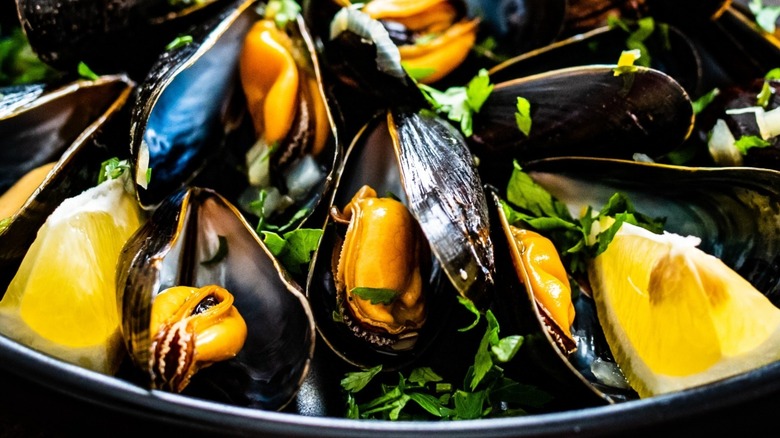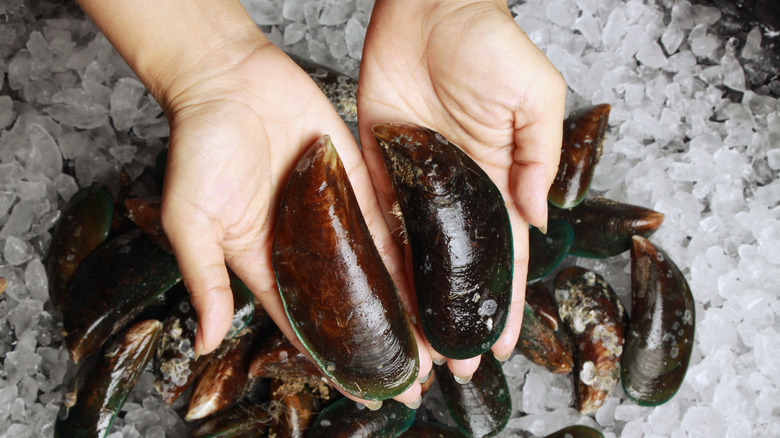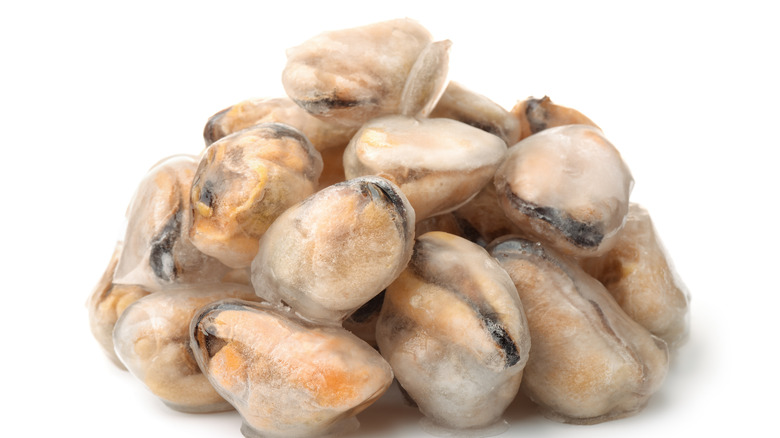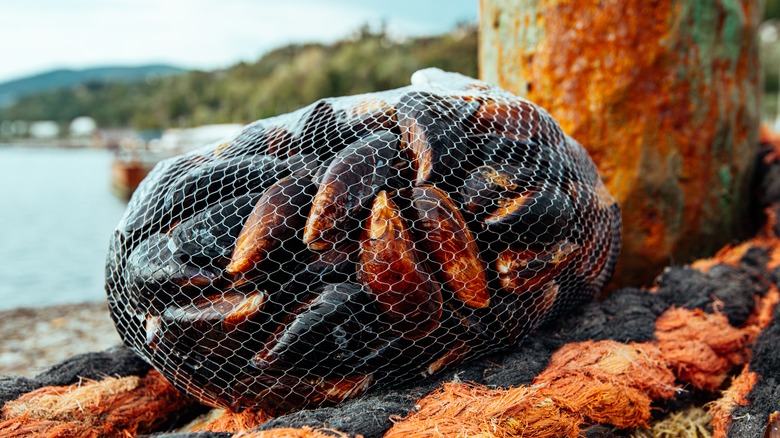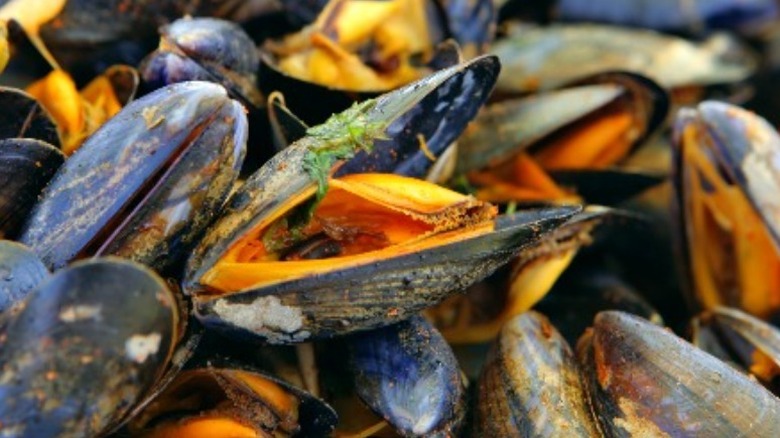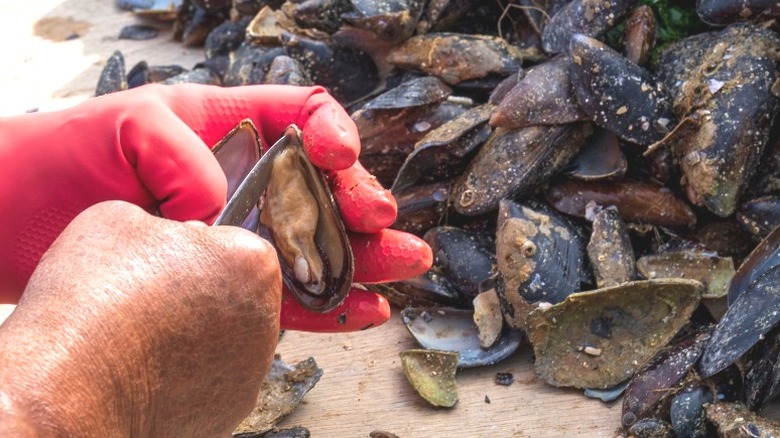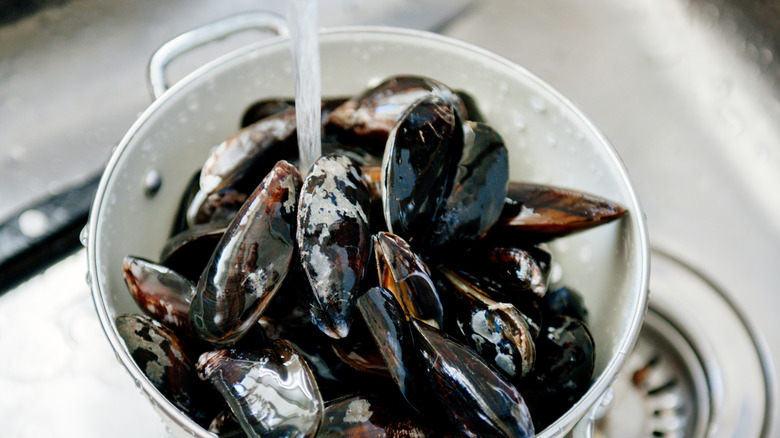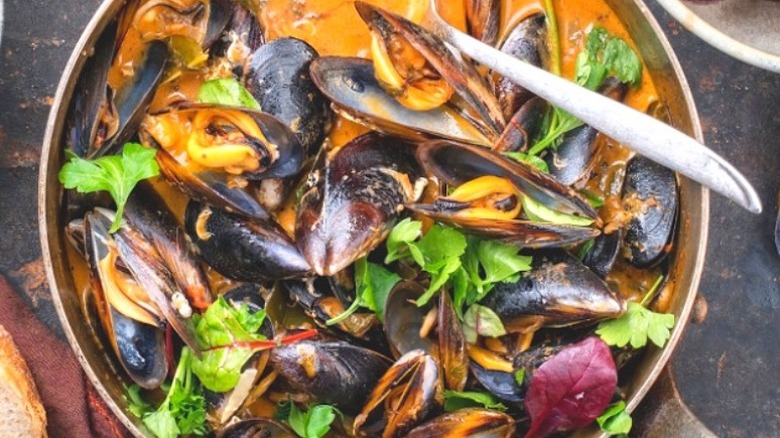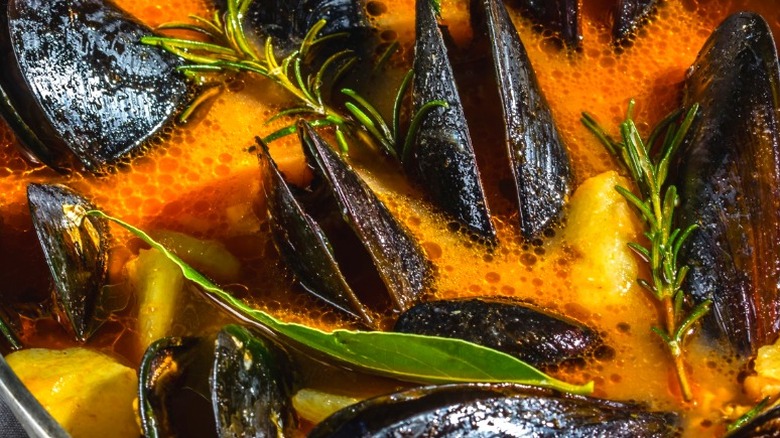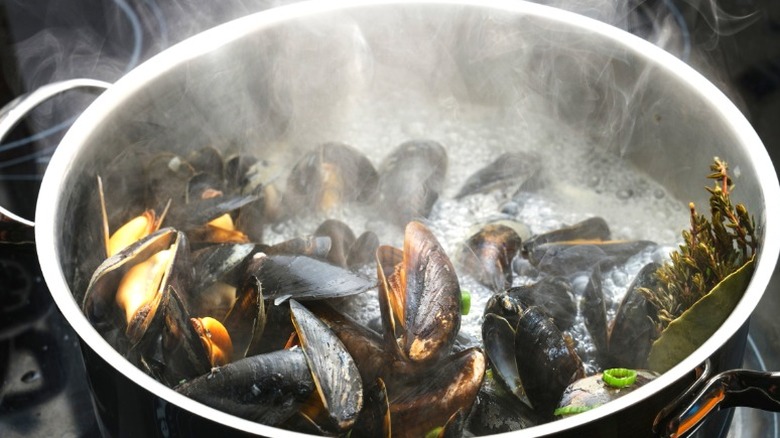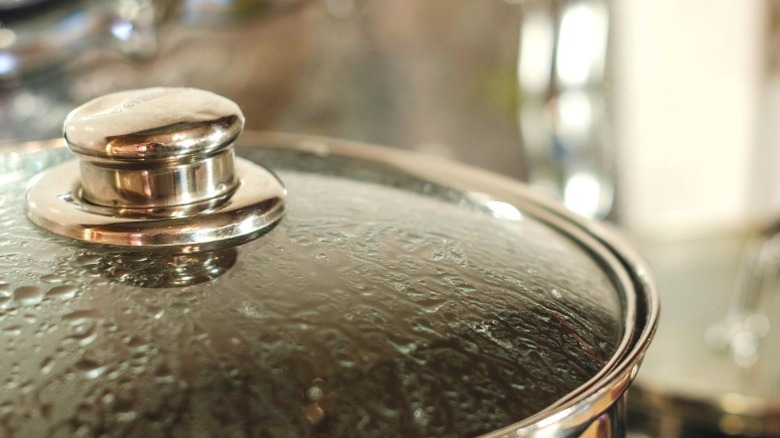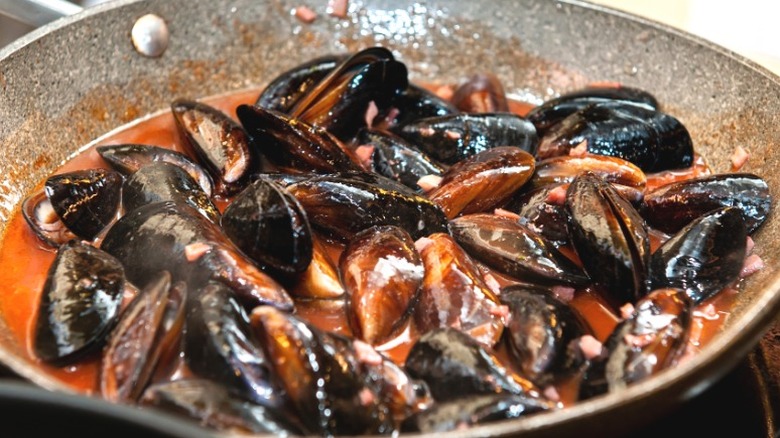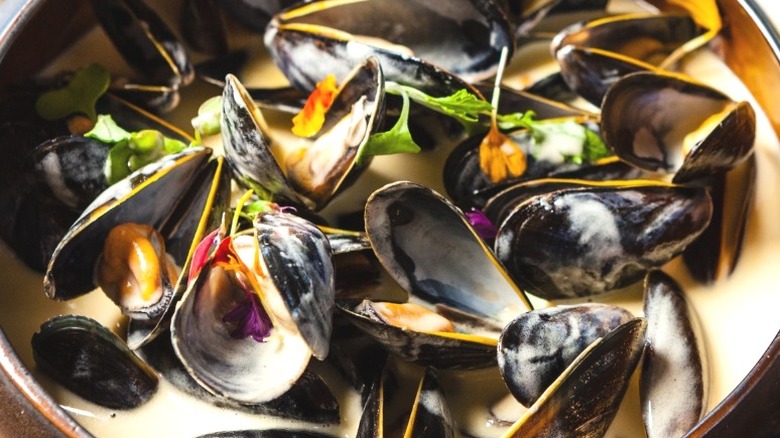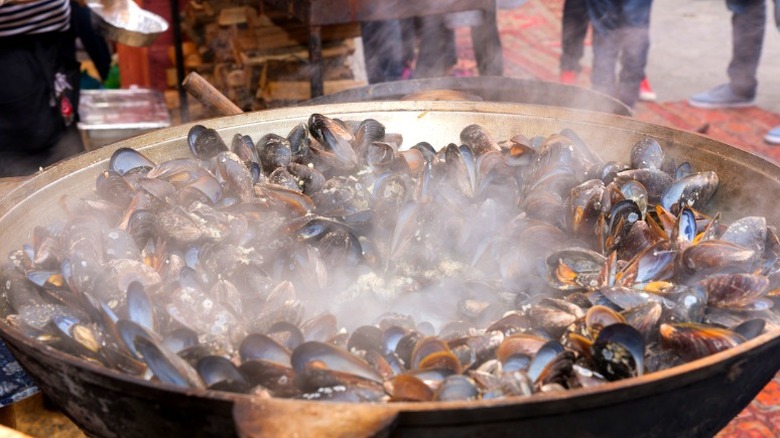Mistakes Everyone Makes When Cooking With Mussels
Mussel cooking mistakes can leave you assuming all mussels taste flavorless, dirty, rubbery, or even vile. However, when you prepare and cook mussels the right way, you'll notice a considerable difference in their taste. If you get any one part of the process of buying, sorting, storing, cleaning, or cooking mussels wrong, you can end up not only with unpalatable seafood but end up at the hospital.
The late chef Anthony Bourdain would never eat mussels in a restaurant without personally knowing the chef and knowing how they'd been stored and kept warm after cooking (via The Guardian). There are just too many things that can go wrong if a restaurant isn't meticulous with how it handles shellfish.
However, there's no reason to be frightened of cooking mussels yourself. As long as you know the possible dangers and all the wrong things to avoid, you can make them the right way and enjoy many delicious mussel dishes. And with the food science tips we've provided, you can stay safe and perhaps make them taste even better than a restaurant's offering.
Not cooking them when they're fresh
You should always cook mussels when they are fresh and alive. Mussels live in a cold, aquatic environment and do not stay alive indefinitely outside their natural habitat. The reason mussels often come packed in ice is to keep them at a temperature that mimics their natural environment so that they can stay alive long enough for you to cook them at home.
Gathering mussels yourself is the best way to ensure freshness. Otherwise, you should ask when they were caught or look for an expiration date to ensure they're not already near death's door. Doris T. Hicks of the University of Delaware says that you can keep them alive by storing them in the refrigerator. However, they will start to die within two or three days, so it's essential to prepare them quickly. Hicks also says you should never store them in an airtight container since they need to be able to breathe.
The FDA recommends they stay at 40 F or below in the refrigerator to avoid bacterial growth. One fridge storage option includes keeping them in their original mesh bag (via Mashed).
However, one of the best ways to refrigerate them is to nestle a bowl of mussels inside a larger bowl of ice. Then, cover the mussels with a wet cloth or paper towel to keep them moist. You should replace the ice as it melts to maintain the ideal temperature to keep them alive and safe to eat (via Cook's Illustrated).
Using mussels that have been frozen
One mussel cooking mistake is starting with frozen mussels. We admit that buying frozen seafood is convenient, but frozen shellfish never tastes as good as when it's fresh. And if you've never tried them before, using frozen mussels for your first mussel recipe is likely to ruin your chances of ever wanting to try them again.
First of all, frozen ones often contain food coloring to give them a uniform pink color. And, when you cook them, their texture will be more like rubber than pleasantly chewy (via Bon Appetit). Kenneth S. Hildebrand, Jr. from Oregon State University says most of the unpleasant flavors in frozen seafood result from drying out and losing moisture during the freezing process. Moisture loss leads to freezer burn, oxidization, and a tough texture. Ultimately, he says that not-so-pleasant changes in seafood's flavor or color come about because of a shift in oxidation in regards to the pigment in unsaturated fatty acids.
Hildebrand also explains that any air left in the container will cause ice crystals to form on the mussels. Evelyn Watts from Louisiana State University says that large ice crystals that form during slow freezing can damage cell walls. So, a vacuum-sealed, flash-frozen package of mussels is your best bet, but it's still not a perfect option.
If you don't mind your seafood tasting like a freezer and having the texture of a rubber boot, go ahead and buy your mussels frozen, but don't say we didn't warn you.
Not buying them when they're in season
If you're a seaside dweller in North America, it's common knowledge to only eat shellfish in months containing the letter "R." Native Americans who understood the dangers of eating shellfish out of season passed this shellfish wisdom down to early settlers. According to their advice, it's safest to eat shellfish in cooler months versus the summer season. (via New York Times).
During warmer weather, eating mussels can put you in danger of consuming algae toxins. Unfortunately, the Washington State Department of Health says that the cooking process doesn't eliminate biotoxins from algae. Depending on how much algal toxins shellfish have accumulated in their flesh, eating them can cause extreme illness or even death.
Summer is also mussel spawning season, and they need time to replenish themselves (via New York Times). Without allowing them time for spawning, our seafood habit can quickly come to a close.
Another reason not to eat shellfish in the summer months is that bacteria levels in the water increase in warm weather. So, there's a greater chance of eating mussels that have cultivated bacteria like Vibrio parahaemolyticus in the summer. Luckily, it's possible to cook mussels at a high enough temperature to kill bacteria, viruses, and parasites (via Washington State Department of Health).
So, any time that you buy or harvest mussels that aren't in season, you are taking a bigger risk than normal of consuming unsafe shellfish. To keep yourself safe, stick to eating mussels when it's cooler weather.
Not sorting through them
Even if you buy fresh, there's no guarantee that every mussel is alive. Thus, sorting and throwing away the dead ones is essential. Sort once during the buying process (if possible) and another time before cooking.
So, how do you tell if your mussels are alive? According to the FDA, their natural response to you tapping their shells is to close their shells. So, be sure to tap all of them to determine if they're all still alive and well. A dead one won't respond. Rigor mortis also sets up quickly in shellfish, so the shell will likely be left partially open after it dies, which can fool you into thinking that done early when it merely started off dead. (via Seafood Services Australia).
Smelly mussels are always a no-go because they are definitely dead. Dead seafood smells fishy after it acquires enough bacteria to convert trimethylamine oxide (TMAO) into trimethylamine (TMA) (via American Society for Nutrition). This results in that unpleasant fishy smell and a live mussel won't have a fishy smell. The FDA says that you should also discard any with broken or cracked shells.
Not cleaning them the correct way
Nobody likes dirt in their food, so you'll want to clean your mussels before cooking them to remove all the sand, mud, seaweed, and barnacles they accumulated while lounging around in the water. If you collect them yourself or get them from a local supplier, you'll want to soak them in cold, salt water before cooking to help remove debris.
However, if you don't relish the idea of spending part of your day cleaning mussels, rope-grown, farmed-raised mussels are a better choice since they don't touch the sandy ocean floor and are they're likely to be fairly free of sand and grit (via WebMD). They will require much less scrubbing. Beyond possible soaking, cleaning involves scrubbing them under cold, salt water and debearding them (via Mashed). MasterClass says that you can either clean the outside of the shells with your hands or a scrub brush. Then, to debeard, you can pull its hairy, seaweed-like tufts toward the hinge of the mussel shell to remove them. Alternately, you can scrape off the beard with a knife.
According to the James Beard Award-winning food writer Harold McGee, the beard is actually part of the mussel's body inside, and pulling on this can cause injury to the mussel. You'll want to hold off until right before cooking to remove the beard. A final saltwater rinse in a colander after scrubbing and debearding can help remove any leftover debris from the process. The cleaner your mussels — the better your meal.
Washing or soaking saltwater mussels in tap water
The Center for Biological Diversity calls freshwater mussels "the most endangered group of organisms in North America." Thus, any mussels that you purchase will be saltwater mussels. And saltwater mussels can't tolerate fresh water. Celebrity chef Alex Guaraschelli warns that storing saltwater mussels in unsalted water can kill them, and you want to keep them alive until cooking (via Mashed).
Purchasing ice-packed mussels allows them to stay alive during transport(via Mashed). Unfortunately, many people mistakenly let the ice melt and then allow the mussels to sit in the resulting unsalted water. Allowing them to sit in meltwater is an honest mistake you can avoid with a little forethought.
People also make the mistake of storing or cleaning their saltwater mussels in fresh water straight from their kitchen sink. Harold McGee explains that when you use water to clean or temporarily store your mussels, you should make a cold solution of salt water that contains "⅓ cup salt per gallon." Your best option is rock or kosher salt without iodine or other additives (via Spruce Pets). Adding ice can help to keep the water cold while you work to clean your mussels.
Not seasoning them properly
A mussel cooking mistake we hope you're never guilty of is not seasoning them properly. You'll enjoy your mussels much more when they have lots of flavor. According to food scientist Harold McGee, mollusks lose some of their savory flavors during cooking. The scientific reason they lose their savoriness is that when the mussel heats up, the amino acids in the meat become trapped inside the congealed protein, which prevents you from being able to taste those richer flavors.
So, to please your tongue's need for flavor, you'll want to add savory flavors while cooking to make them taste their best. Most recipes you will find for mussels will include savory herbs, alums, and aromatics to bring out their best flavor. However, if they don't, you can always add some to match your tastes.
Mussels pair well with alums and aromatics like garlic, shallots, or red pepper. Savory herbs like parsley, chervil, tarragon, fennel, lemongrass, and thyme can go well with them. Plus, they're also good with tomato sauce, coconut, and even curry (via Tasting Table).
Using water instead of another liquid for cooking
Another mussel cooking mistake is using water instead of a flavorful liquid during the cooking process. If you prefer broth, the best options are lighter broths like chicken broth, vegetable broth, or seafood broth. And the same wines and beers that pair well with mussels for eating pair well with them for cooking.
Shellfish pair best with light white wines. So, consider light white wines like Chardonnay or Sauvignon Blanc as your cooking liquid. Using dry wines is to avoid sweetening your dish. A cider is also a possibility since it provides flavor without added sweetness.
Alternately, if beer is more your style, consider lighter beers like pale ales, pilseners, saisons, or light wheat beers. However, even going with a stronger-tasting beer like a porter can work. Some cooks like to use the beer for steaming and then add extra beer at the end to stop the cooking process when the mussels are done (via Beer Advocate).
Not steaming or poaching your mussels
If you've only tried dry cooking methods with your mussels before, this might be one of your mussel cooking mistakes. If you're not steaming or poaching your mussels, you're not getting as much flavor from them as you could, which is a shame if you've done everything else correctly.
Many people use dry heating methods like frying, grilling, and baking when they cook shellfish. These cooking methods result in temperatures that are high enough for the mussels to brown from the Maillard reaction. However, they don't unlock as much flavor potential as possible. Harold McGee says that using what could be described as "moist techniques" like steaming and poaching can add more flavor to shellfish since it incorporates the tastes of the other ingredients you add to the pot.
Steaming prevents flavor and nutrients from leaching out and leaves behind more vitamins and minerals in comparison to other cooking methods (via Healthline). Meanwhile, poaching has the potential to infuse your mussels with even more of the flavors from your liquids, aromatics, alums, herbs, or other flavorful ingredients.
Not covering your pot
When cooking with moist heat, you want to cover the pan to ensure that your mussels are all coming into contact with the moisture from the cooking process. Covering the pan harnesses the power of all the moist heat in the pan rather than allowing some to escape.
Steam begins to rise after the liquid in your pan goes beyond the boiling point (higher than 212 F). But if the mussels are not fully submerged in the liquid, they depend on the flavorful steam circulating through your pan as part of the cooking process. Ultimately, you want the mussels to cook in their own juices that the steam helps to create, while any other liquid and seasonings you add all combine for a flavorful sauce (via Tasting Table).
Unfortunately, if you don't have a lid on the pot, you're allowing steam to escape rather cooking your food with it. If the steam isn't circulating throughout the pot, you're more likely to end up with mussels that get done at different times.
Undercooking your mussels
The most dangerous mussel cooking mistake is undercooking them. Undercooked shellfish may contain illness-causing or deadly bacteria, viruses, or parasites. Food scientist Harold McGee says that eating raw and undercooked bivalve shellfish is especially risky because they filter through the seawater for food and often end up acquiring bacteria and viruses at the same time.
Viruses and bacteria like Vibrio and botulism can result in death, Hepatitis can cause liver damage, while Norwalk viruses cause vomiting and diarrhea. Luckily, McGee says that cooking shellfish to 140 F can kill bacteria and parasites, while temperatures above 185 F will kill some viruses.
Doris T. Hicks of the University of Delaware says you should steam mussels in an uncrowded pot for four to nine minutes to be safe. You will know that your mussel is fully cooked when it opens up to reveal the cooked meat of the mussel inside. However, don't be fooled by mussels that open earlier in the process than you expect because they may not be done yet.
What do properly cooked mussels look like? Hicks says that they should be opaque and have plumpness to them when properly cooked. The meat should also detach from the shell (via Seafood Services Australia). Any shells that don't open during the normal cooking time are possibly not done or have something wrong with them, so you should toss them (via FDA).
Overcooking your mussels
One of the biggest and most disappointing mussel cooking mistakes is overcooking. If you overcook mussels, their texture changes, making them rubbery and tough, or they will have a disagreeable flavor that can either be too weak or too strong. Many people who think they don't like mussels had their first mussel-eating experience with overcooked mussels and gave up on them almost immediately.
It's a good idea to set a timer and keep a close watch on your pot starting at the four-minute mark since that's the earliest you should expect any of the mussels to be done (via Doris T. Hicks). Gentle cooking without high heat is also essential to ensure that shellfish don't fall apart or gain a rubbery rather than chewy texture (via Encyclopedia of Meat Sciences).
It can be tempting to overcook mussels if you notice several unopened ones. However, cooking for even 90 extra seconds while waiting for those few closed mussels to open can result in overcooking the other mussels that are already done (via Seafood Services Australia). Some cooks remove individual mussels when they're done cooking to allow the slower-cooking ones more time.
Overcrowding the pot
Cooking guru Rachel Ray says that overcrowding the pot is one of the biggest mistakes cooks make in the kitchen (via Mashed). If you make the mussel cooking mistake of overcrowding the pot, you prevent each mussel from having equal access to heat and moisture to get done. As a result, you will end up with mussels in a different state of doneness.
Harold McGee says that the best way to prevent tough mussels is to cook them in a single layer across a large pan. Then, it's easier to find and remove any of the mussels that open early so that they don't become too tough while the others are still cooking. If you overcrowd your mussels in the pan, the internal moisture may not be able to escape the shells. Crowding can also prevent the meat from reaching the right temperature (via Huff Post).
Real Simple advises that if you have more mussels to cook than will fit the pan with room to spare, you should cook them in multiple batches instead of trying to cook them all at once. You can keep early batches warm on a foil-covered plate. If you tent the foil, it can help keep the heat circulating to keep them warm (via Real Simple).
However, be sure not to leave them out too long because the FDA warns that bacteria will begin to grow when shellfish temperature hovers between 40 degrees and 140 degrees.
